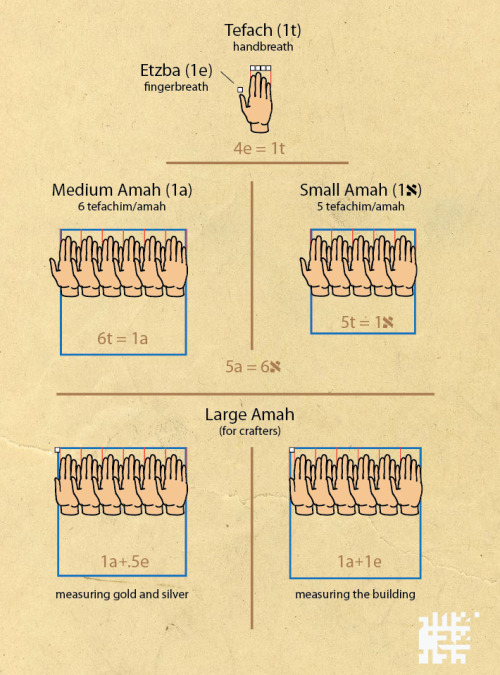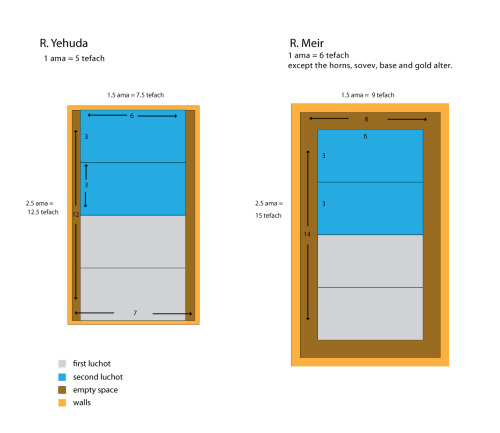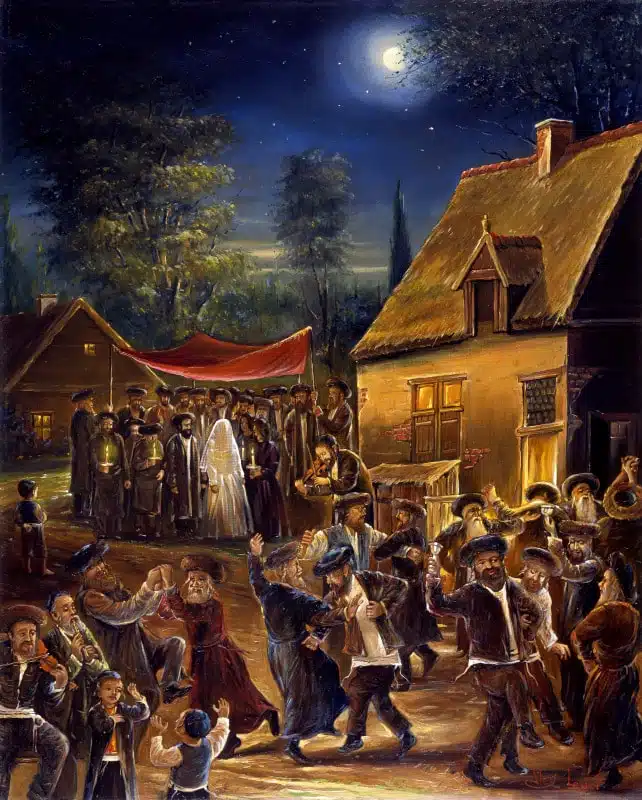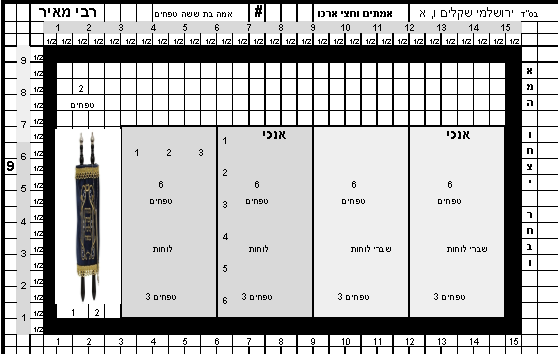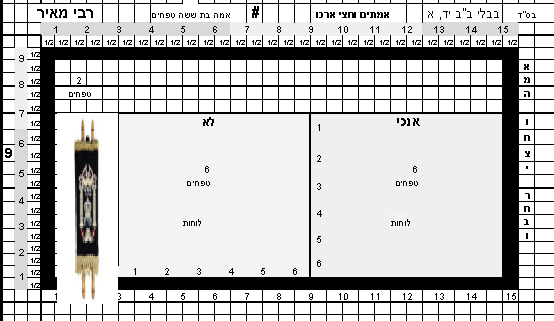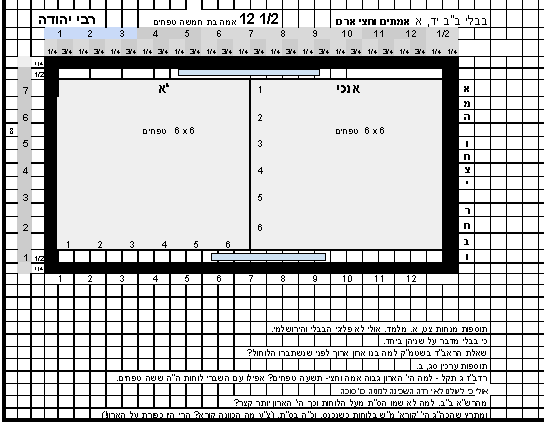BSD
Shkolim 16b (2)
16 Kislev, 5785. 12/18/2024
1 – Continued the topic of the לוחות וספר תורה that were inside (or outside) the ארון in the קודש הקדשים.
2 – The גמרא explains the construction of the ארון. Either it was made of 3 boxes (as Rashi says in חומש) or just one box plated with gold.
3- Next topic of the גמרא is the עשרת הדברות that were engraved on the לוחות.
The simple and accepted way we see around us are simply 5 on one tablet and 5 on the other.
However the גמרא brings a 4 way מחלוקת as to how many times the עשרת הדברת were actually engraved on the לוחות.

כֵּיצד הָיוּ הַלּוּחוֹת כְּתוּבִים.
רִבִּי חֲנַנְיָה בֶּן גַּמְלִיאֵל אוֹמֵר. חֲמִשָּׁה עַל לוּחַ זֶה וַחֲמִשָּׁה עַל לוּחַ זֶה….
וְרַבָּנִן אָמְרִין. עֲשָׂרָה עַל לוּחַ זֶה וַעֲשָׂרָה עַל לוּחַ זֶה….
רִבִּי שִׁמְעוֹן בֶּן יוֹחַי אָמַר. עֶשְׂרִים עַל לוּחַ זֶה וְעֶשְׂרִים עַל לוּחַ זֶה…..
רִבִּי סִימַאי אָמַר. אַרְבָּעִים עַל לוּחַ זֶה וְאַרְבָּעִים עַל לוּחַ זֶה….. טֶטְרַגוֹנָה.
How were the לוחות written?
Rebbi Ḥanania ben Gamliel says, five on one tablet each…. (Total of 10)
The Rabbis say, ten on each tablet….(Total of 20)
Rebbi Simeon ben Yocḥai said, twenty on each tablet…..(Total of 40)
Rebbi Simai says, forty on each tablet, a square.(Total of 80)
On the surface the numbers of 10 and 20 seem simple enough. 5 on each, for a total of 10, or the full 10 on each, for a total of 20. (We discussed the suggested answers as to the purpose of this ‘copy paste’ onto the 2nd tablet).
However, what does the ‘20 on each tablet’ mean? Or ‘40 on each tablet mean’?
We discussed various explanations. Some are a bit complicated. Here is one:
4 – The רדב”ז suggests that to understand the above 4 opinions we need to take into account a few of the ניסים pertaining to the לוחות.
See here.
#1 -The writing on the לוחות went thru the לוחות. Meaning that they were engraved from the front to back. מִזֶּה וּמִזֶּה הֵם כְּתוּבִים on each side they were written.
As the גמרא says in שבת קד, א that this unique engraving caused the letters ם and ס to be floating.

#2 – What did the writing that appeared on the reverse side look like? Was it read from right to left? For example: אנכי? Or left to right – meaning backwards? For example: יכנא?
The above גמרא says that it was backwards!
וְאָמַר רַב חִסְדָּא כְּתָב שֶׁבַּלּוּחוֹת נִקְרָא מִבִּפְנִים וְנִקְרָא מִבַּחוּץ כְּגוֹן: נְבוּב בובן (רַהַב בָּהָר) סָרוּ ורס.

Rav Ḥisda said: The writing on the tablets was read from the inside, from one side of the tablets, and read from the outside, the other side of the tablets, in reverse order. The Gemara cites words that appear elsewhere in the Bible: Nevuv was read as bet, vav, bet, nun; rahav as beit, heh, reish; and saru as vav, reish, samekh.
[This cryptic גמרא will be discussed BL”N at the next shiur].
So even according to the opinion that only 5 were engraved on each of the לוחות (for a total of 10) it means that it was read on both sides, (albeit backwards) for a total of 20 times.
We discussed how, based on these two above points, the רדב”ז explains the 4 way מחלוקת.
The opinion of רִבִּי חֲנַנְיָה בֶּן גַּמְלִיאֵל is that each side had only 5.
The רַבָּנִן say that each side had the full 10.
According to both, the back side of the לוחות also had the עשרת הדברות, but in reverse order.

[In a sense – every side, front and back, ‘faced forward’. That is perhaps the meaning of what the Alter Rebbe writes in Tanya, quoting our גמרא,
שמשם נמשכו הלוחות שבארון כמ”ש כתובים משני עבריהם כו’ וכמ”ש בירושלמי דשקלים שלא היתה בהן בחי’ פנים ואחור ע”ש:]
רִבִּי שִׁמְעוֹן בֶּן יוֹחַי adds (to the opinion of the רבנן) that there was another miracle here. Despite the engraved letters on the back of the לוחות being reversed, when reading them they were seen going in the right direction!
So the 10 are actually 20, since they are easily readable from both sides.
רִבִּי סִימַאי opinion is that עשרת הדברות were readable from all four sides. The רדב”ז explains: Imagine the לוחות standing upright in the middle of the room with all four sides visible and readable. Thus the number 40.

5- We briefly discussed the famous מחלוקת of the ראשונים regarding מזוזות and ספרי תורה if to place them horizontally or vertically.
In short- The גמרא says that one should not affix a מזוזה like a ‘nail’ (or peg, pin, bolt etc) – נגר.

The question in what direction is a regular nail driven into a wall? If vertically, then a מזוזה must be affixed horizontally and vice versa.

רש”י the רמב”ם and many other say that a מזוזה must be affixed upright – vertically.
רבינו תם however says that it’s not דרך כבוד to have them upright.
מנחות לג, א. Here.

To use his expression – ‘we find that ‘upright’ is used when burying mules’!

Another point says רבינו תם, quoting our גמרא, is that we find the לוחות in the ארון were placed horizontally although they would easily have fit if placed upright. The reason they were placed flat is because that is the honorable position for them.

להלכה we place מזוזות at an angle but we place the ספרי תורה in an upright position.
6- Yossi Cohen suggested a fascinating story of a burial ‘face down’.
Rabbi Meir passed away on the 14th of the Hebrew month of Iyar while in exile outside of the Holy Land His remains were brought to Tiberias and entombed close to his teacher Rabbi Akiva. The Rabbi requested that his body be buried in a standing position as the Torah uses the word “standing” in reference to prayer.
Another version of this legend says that the Rabbi wanted to be buried standing up so that when the Messiah came he could walk straight out to greet him. Before his passing, the Rabbi said that his legacy to generations to come would be that he would intercede in heaven on any person’s behalf if the person is willing to give charity to the poor of Israel in his memory.
face down, not standing up
https://ohr.edu/ask_db/ask_main.php/242/Q4/
This reminds me of a story, that I find frightening, one which illustrates the frightening evil to which a human can sink and, at the same time, the wisdom of our Sages: Not far from Luban, Russia, there lived a Jew who was a traitor to his people; he spent his life harassing the Jewish community by slandering them to the Russian authorities at every opportunity. At the end of his life, as he lay on his death bed, he summoned the Jewish burial society. “Bury me face down,” he said. Then he died.
His most odd request was brought to the great Rabbi Moshe Feinstein. Rabbi Feinstein ruled that, despite the requirement to fulfill a dead person’s final wishes, he must nevertheless be buried face-up in accordance with Jewish Law.
A few days after the funeral, the Russian authorities rode into town and summoned the Jewish burial society demanding that the recently buried body be dug up. Mystified, the Jews went out to the cemetery and began digging under the watchful eye of the Russians. When the body was unearthed and became visible, the Russians said, “Enough. Bury him again.” Now the Jews couldn’t contain themselves: “Please explain why you wanted to dig him up?” they asked.
“This man,” the Russians explained, “was our friend. He was forever loyal to us. He told us that the Jews hate him so much for being our friend that they are going to bury him face down!”

